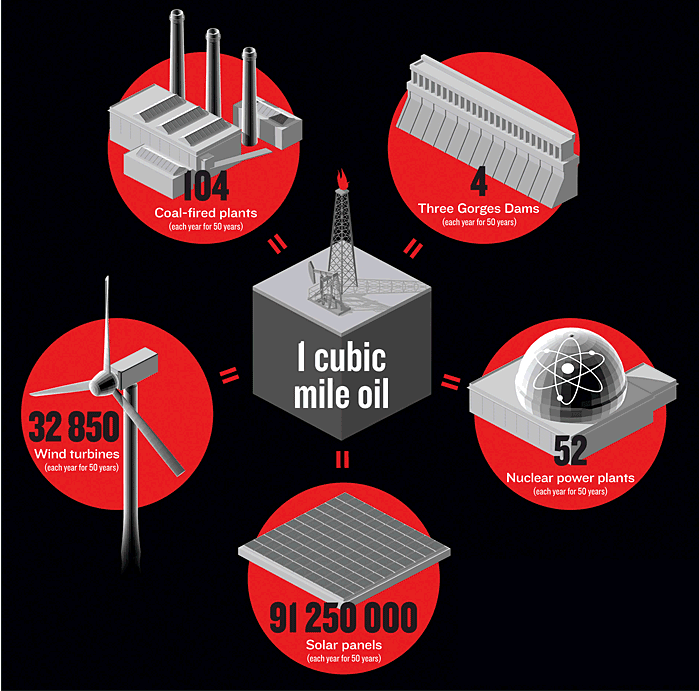To replace just one year of world oil use (1 cubic mile) you’d need to mine, fabricate, deliver, and build 91,250,000 Solar panels every year for 50 years (Goldstein).
A PV plant that could produce 5.5 TWh of power (what the Glen Canyon dam produces) would displace an enormous ecosystem, about 20 square miles. It requires 177,788 MT (megatons) of aluminum, 2,222,356 MT cement, 480,029 MT copper, 7,556,010 MWh of electricity, and 4,600,276 MT of steel (Pacca).
Ted Trainer estimates that building a PV power plant would cost at least 48 times as much as building a coal power plant. 2003. Renewable Energy: What are the Limits?
Primary power consumption today is 12 TW, of which 85% is fossil-fueled. The electrical equivalent of 10 TW would require a PV array of 85,000 square miles, more than all the land in Kansas. Yet during the 16 years from 1982 to 1998, only 1.16 square miles of PV cells were produced. At that rate, it would take over a million years to produce enough PV cells. Existing grids could not manage the loads of this enlarged system since the current hub-and-spoke networks were designed for central power plants, close to cities (Hoffert). 85,000 square miles of land would be ruined for ranching, farming, and forests. This would certainly have a huge environmental impact. All of these 85,000 square miles needs to be constantly maintained and replaced as well. Hail, lightning, tornadoes, hurricanes, floods and other natural disasters would further reduce their lifetime and increase the amount of energy required to keep them going.
Non-PV Solar Farms Can only be built in deserts
Deserts are usually far from cities, and require an enormous investment in electric grid infrastructure. Solar farms of any kind are vulnerable to high winds, hail, tornadoes, storms, hurricanes, and sand storms scouring the mirrors. Large amounts of water are needed to rinse off the mirrors. Howard Hayden estimates Solar Two would need to take up 127 square miles to produce as much energy as a 1000-MWe power plant does in one year (Hayden).
Goldstein, H; Sweet, W. Jan 2007. Joules, BTUs, Quads-Let’s Call the Whole Thing Off. 2.1â”kilowatt system made for home roofs are required. IEEE spectrum.
Hoffert, M.I., et al. “Advanced Technology Paths to Global Climate Stability: Energy for a Greenhouse Planet.” Science 298 (November 1, 2002):981-987
Howard Hayden. 2005. The Solar Fraud: Why Solar Energy Won’t Run the World, Second Edition. Vales Lake Publishing.
Pacca, S. 2002. Greenhouse Gas Emissions from Building & Operating Electric Power Plants in the Upper Colorado River Basin. Env Sci & Tech /Vol 36, # 14 3194-3200

